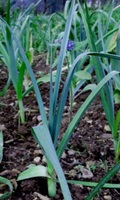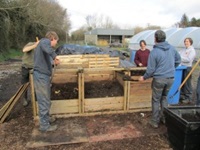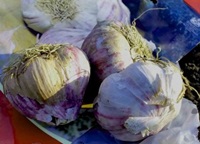
Have you been planning to grow your own vegetables but haven’t started yet? Perhaps you’ve begun growing your own but aren’t sure if you’re doing the right thing? With all the good intentions in the world, sometimes it’s difficult to take the first steps or spend the time to learn more. Perhaps you’ve just been too busy to start a new project, or you simply don’t know where to begin. If that sounds familiar, here are the three most useful things I learnt when we began working in the vegetable garden that may help you to grow your own successfully.
1. Start Small.

Even if you’d like to grow lots of veggies, don’t attempt to be fully self-sufficient in the first year. Plan big but start small, only clearing enough space or building enough beds to get you started.
We began with two beds, increasing ever year until we now have 17, but even as an enthusiast I unearthed leeks this week I’d forgotten about, buried deeply under weeds. They were healthy enough but would have been much bigger if they hadn’t been competing for space.
If you clear too much land at once you may find it daunting to keep up as the weeds begin to grow. One of the busiest times of the year isn’t springtime as you might expect with all the sowing and planting, but later during the summer and autumn as you start to harvest and then have to find time to pick, preserve, pickle or freeze your produce. Starting small will allow you to see how much time you have to grow your own food and whether it’s something you’d like to do more.
2. It’s all about the soil.
What we add to the soil now will repay us in produce later. As you can see in the short video clip above, fertile soil is vital to our existence. Did you know it takes 2,000 years to create just 10cm of topsoil? We ignore it at our peril. Adding well-rotted organic matter to the soil in the form of garden compost or old farmyard manure will help to feed it with vital nutrients as well as help with soil texture and drainage.

Autumn/Fall is a good time to prepare for the following year as it will allow the microbes, organisms and worms to do their job over winter, incorporating all the goodness you’ve added, back into the soil.
Don’t worry too much if you miss the opportunity to get some winter preparation done, it’s not too late to do it in the springtime. Just leave three or four weeks between preparing the soil and sowing time, which will allow weed seedlings to grow and you to remove them. However, don’t work the soil when it’s too wet or frozen or you can do more damage than good.
A general guide for adding organic matter in the autumn is to add about one, big bucketful of well-rotted organic matter per square metre to the top of the soil but more wont do it any harm. Once added, cover with cardboard, weed membrane or black plastic and leave it be until the springtime. A couple of weeks before you plan to sow your seeds remove the cover and lightly fork any remaining organic matter in, before raking the surface of the soil flat.
One essential soil tip before we move onto the third point, and especially vital to remember if you’re visiting a garden or you could attract a fierce look of displeasure from the gardener: avoid walking on garden soil at all costs as over time it will compact. Soil and plants need air for healthy growth. If you have to walk on your soil, place a wooden board down first which will help to distribute your weight more evenly.
3. Vegetables live in families.

Vegetables don’t particularly like to be split up and scattered around the beds. Where possible, plant them in their families. You may have heard of Alliums (onions, garlic, leeks) and Brassica (cabbage, kale, broccoli) but there are several other families too. Here’s a list of the most popular. If you plant vegetables in their families, they will be easier to feed, care for and protect from pests and disease. Planting vegetables in families will also help you to plan and remember where they have grown before as you move them around from year to year in what’s known as crop rotation.
There’s lots more you can learn that will help you to grow your own vegetables successfully such as figuring out what are the easiest or best vegetables to grow, the importance of keeping seeds dry, as well as pests and diseases to look out for. I’ve written several blog posts to help you in your quest to grow your own vegetables, just take a look under the Vegetable Garden Tab here.
Have you started to grow your own yet or is it something you plan to do next year?

Dee Sewell – a horticulturalist and certified trainer who started Greenside Up in 2009 and teaches people how to grow vegetables. Dee specialises in working with community gardens but also offers workshops, allotment visits, consultations, horticultural therapy, afterschools clubs as well as local talks – she tailors her services to meet clients needs. In 2012 Dee launched a Seed Gift Collection containing varieties of vegetable and insect friendly flowers with the aim of getting more people growing. Dee’s blog was a finalist in the 2012 Ireland Blog Awards in the Eco/Green and Lifestyle Categories.
Source: GreenSideUp – als You Need To Know To Help You Grow Your Own Vegetables – Dee Sewell





